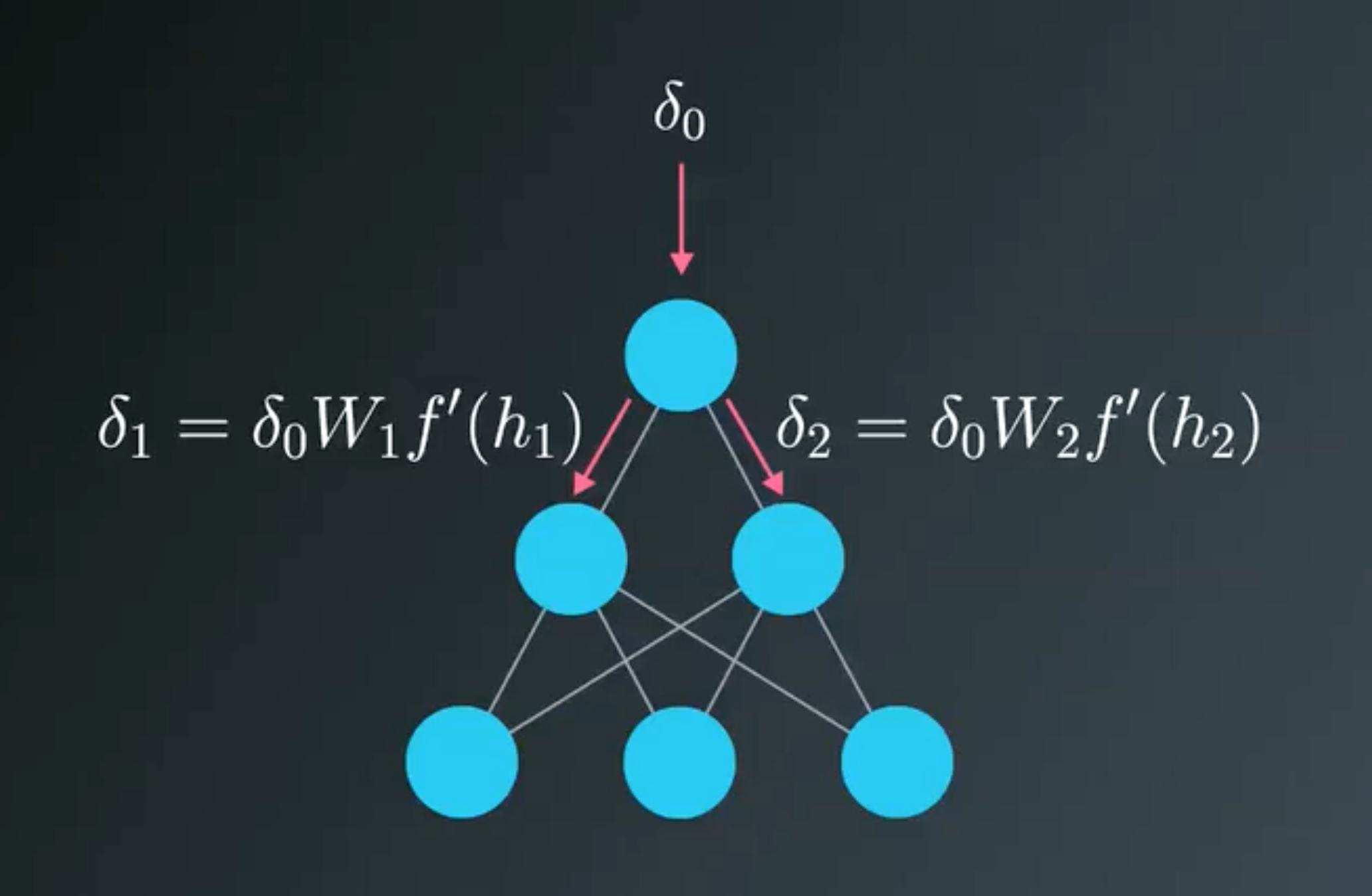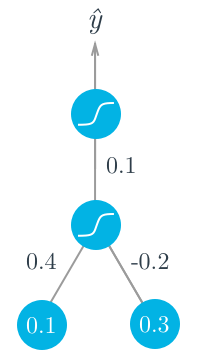Backpropagation
Outline:
Backpropagation
- How to make a multilayer neural network learn.
- The backpropagation algorithm using the chain rule to find the error with the respect to the weights connecting the input layer to the hidden layer (for a two layer network).

- To update the weights to hidden layers using gradient descent
- How much error each of the hidden units contributed to the final output
- The output of a layer is determined by the weights between layers, the error resulting from units is scaled by the weights going forward through the network.
- We know the error at the output, we can use the weights to work backwards to hidden layers.
The error attributed to hidden unit is the output errors, scaled by the weights between the output and hidden layers (and the gradient):

The gradient descent step is the same as before, just with the new errors:

The weight steps are equal to the step size times the output error of the layer times the values of the inputs to that layer

Example
- Two input values, one hidden unit, and one output unit.
- Sigmoid activations on the hidden and output units.

Backpropagation Code
Code:
import numpy as np
def sigmoid(x):
"""
Calculate sigmoid
"""
return 1 / (1 + np.exp(-x))
x = np.array([0.5, 0.1, -0.2])
target = 0.6
learnrate = 0.5
weights_input_hidden = np.array([[0.5, -0.6],
[0.1, -0.2],
[0.1, 0.7]])
weights_hidden_output = np.array([0.1, -0.3])
## Forward pass
hidden_layer_input = np.dot(x, weights_input_hidden)
hidden_layer_output = sigmoid(hidden_layer_input)
output_layer_in = np.dot(hidden_layer_output, weights_hidden_output)
output = sigmoid(output_layer_in)
## Backwards pass
## TODO: Calculate output error
error = target - output
# TODO: Calculate error term for output layer
output_error_term = error * output * (1 - output)
# TODO: Calculate error term for hidden layer
hidden_error_term = np.dot(output_error_term, weights_hidden_output) * hidden_layer_output * (1 - hidden_layer_output)
# TODO: Calculate change in weights for hidden layer to output layer
delta_w_h_o = learnrate * output_error_term * hidden_layer_output
# TODO: Calculate change in weights for input layer to hidden layer
delta_w_i_h = learnrate * hidden_error_term * x[:, None]
print('Change in weights for hidden layer to output layer:')
print(delta_w_h_o)
print('Change in weights for input layer to hidden layer:')
print(delta_w_i_h)
Output:
Change in weights for hidden layer to output layer:
[ 0.00804047 0.00555918]
Change in weights for input layer to hidden layer:
[[ 1.77005547e-04 -5.11178506e-04]
[ 3.54011093e-05 -1.02235701e-04]
[ -7.08022187e-05 2.04471402e-04]]
Nice job! That's right!
Implementing Backpropagation
- The error term for the output layer:
- The error term for the hidden layer:
- A simple network with one hidden layer and one output unit
- Data preparation and data is same as the previous example
Code:
import numpy as np
from data_prep import features, targets, features_test, targets_test
np.random.seed(21)
def sigmoid(x):
"""
Calculate sigmoid
"""
return 1 / (1 + np.exp(-x))
# Hyperparameters
n_hidden = 2 # number of hidden units
epochs = 900
learnrate = 0.005
n_records, n_features = features.shape
last_loss = None
# Initialize weights
weights_input_hidden = np.random.normal(scale=1 / n_features ** .5,
size=(n_features, n_hidden))
weights_hidden_output = np.random.normal(scale=1 / n_features ** .5,
size=n_hidden)
for e in range(epochs):
del_w_input_hidden = np.zeros(weights_input_hidden.shape)
del_w_hidden_output = np.zeros(weights_hidden_output.shape)
for x, y in zip(features.values, targets):
## Forward pass ##
# TODO: Calculate the output
hidden_input = np.dot(x, weights_input_hidden)
hidden_output = sigmoid(hidden_input)
output = sigmoid(np.dot(hidden_output,
weights_hidden_output))
## Backward pass ##
# TODO: Calculate the network's prediction error
error = y - output
# TODO: Calculate error term for the output unit
output_error_term = error * output * (1 - output)
## propagate errors to hidden layer
# TODO: Calculate the hidden layer's contribution to the error
hidden_error = np.dot(output_error_term, weights_hidden_output)
# TODO: Calculate the error term for the hidden layer
hidden_error_term = hidden_error * hidden_output * (1 - hidden_output)
# TODO: Update the change in weights
del_w_hidden_output += output_error_term * hidden_output
del_w_input_hidden += hidden_error_term * x[:, None]
# TODO: Update weights
weights_input_hidden += learnrate * del_w_input_hidden / n_records
weights_hidden_output += learnrate * del_w_hidden_output / n_records
# Printing out the mean square error on the training set
if e % (epochs / 10) == 0:
hidden_output = sigmoid(np.dot(x, weights_input_hidden))
out = sigmoid(np.dot(hidden_output,
weights_hidden_output))
loss = np.mean((out - targets) ** 2)
if last_loss and last_loss < loss:
print("Train loss: ", loss, " WARNING - Loss Increasing")
else:
print("Train loss: ", loss)
last_loss = loss
# Calculate accuracy on test data
hidden = sigmoid(np.dot(features_test, weights_input_hidden))
out = sigmoid(np.dot(hidden, weights_hidden_output))
predictions = out > 0.5
accuracy = np.mean(predictions == targets_test)
print("Prediction accuracy: {:.3f}".format(accuracy))
Output:
Train loss: 0.251357252426
Train loss: 0.249965407188
Train loss: 0.248620052189
Train loss: 0.247319932172
Train loss: 0.246063804656
Train loss: 0.244850441793
Train loss: 0.243678632019
Train loss: 0.242547181518
Train loss: 0.241454915502
Train loss: 0.240400679325
Prediction accuracy: 0.725